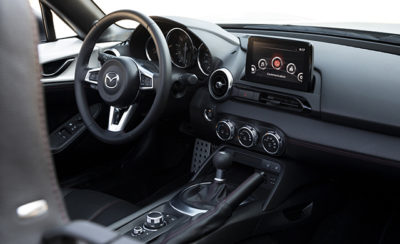For Mazda, the steering wheel connects enthusiast drivers with the soul of the car
The very first automobiles used levers and a tiller to operate and maneuver, but it wasn’t long before the humble steering wheel found its way as standard fare. But in more than 120 years of motoring, the basic premise of the steering wheel hasn’t changed much, especially when compared to how much the car has evolved. Along with the seat and pedals, the steering wheel is really the driver’s only physical connection to the car, so we talked with Mazda Director of Automotive Design, Ken Saward, to learn about how Mazda considers the steering wheel as part of its philosophy of “human-centricity-focused design”
“The first step in designing a steering wheel for a Mazda doesn’t focus on the steering wheel itself, but rather on the driver’s position in the car in relation to the steering wheel,” explains Saward. “If we don’t get that right, then the Jinba Ittai feeling (driver and car are one) that we strive for won’t transpire.
“As far as the steering wheel itself, how it feels in your hands, the shape and the thickness all play a big role in how a driver will feel connected with the car,” he continues. “It’s what contributes to the feeling of control.”
There’s no doubt that those factors matter, but they are subjective. So how does Saward’s team reach a final steering wheel design that will drive a variety of people to the same conclusion?
“We spend a lot of time on that, and there are a variety of areas that contribute to the final design,” says Saward. “Some are subjective, and part of that is benchmarking a lot of cars from other companies to try to discern the common attributes that make a steering wheel feel right. And then there are objective factors, like the ergonomic measurements of the driver’s position relative to the wheel. For example, how high the legs are in relation to the steering wheel could have an influence on the wheel diameter. And last, there are engineering attributes that come into play, like turning radius. It’s all put into an ‘equation’ to come up with the optimum solution.”
Saward goes on to say that car model and type also play a factor. Sportier cars tend toward thicker diameter wheels, and if there are paddle shifters, then that, too, needs to be taken into consideration.
When he’s not leading the design direction for Mazda’s production vehicles, Saward may be out competing in a Spec Miata race, and that experience informs how the steering wheel for the MX-5 and Mazda3 were designed.
“Material is a big thing,” Saward explains. “The wheel needs to feel good in your hands, even through gloves, so we want to make sure that the grip is solid. A thicker rim and smaller diameter also contribute to a sportier feel. We also focus on what the wheel feels like at the nine-and-three or 10-and-two positions.”
Rim thickness in particular, Saward notes, is looked at from an ergonomic standpoint where a thicker rim helps reduce hand fatigue under the stress of racing or high performance driving.
Motorsport has also had an influence on the production car steering wheel with continued increase of technology on the steering wheel. Single-seater and prototypes have been using the steering wheel as the car’s nerve center for decades, and now that same theory of putting more technology at the driver’s fingertips has become commonplace in production cars.
“There’s no doubt that so many things on production cars have trickled down from motorsport, and the steering wheel is certainly one of them. The principle is the same for both, which is minimizing a driver’s need to look away from the road to make an adjustment,” says Saward.
When it comes to grassroots racers, Saward’s advice is the same as what goes into production cars, which is that it all starts with ergonomics. Only once the seating position and the relationship to the steering wheel is dialed in should the driver start to think about what kind of tech to add. Keeping it simple is best, and that, of course, will depend on the car’s level of on-the-fly adjustability.
And finally, in an increasingly touch screen world, is Saward ready to predict the eventual end of the steering wheel?
“No, I don’t see that happening,” he says. “When something works well, there’s no incentive to change it, and the steering wheel is still fundamentally the best way to control a car. What I do see is the steering wheel becoming more advanced so that, for example, the steering ratio can be adjusted with a button to make a u-turn so that only a half rotation is needed.”


 ACCESSIBILITY
ACCESSIBILITY